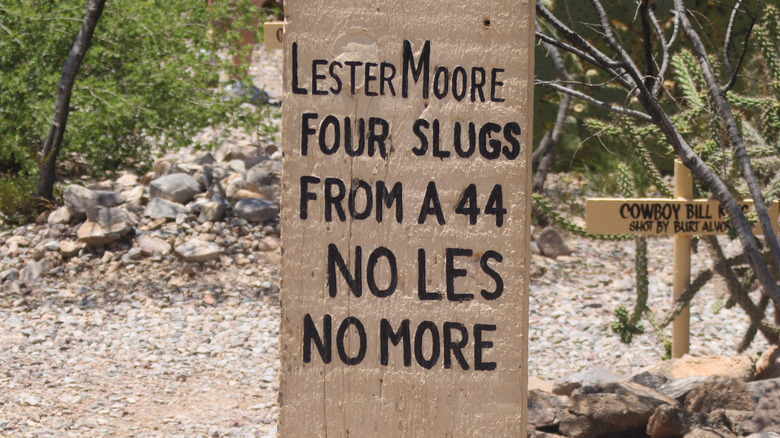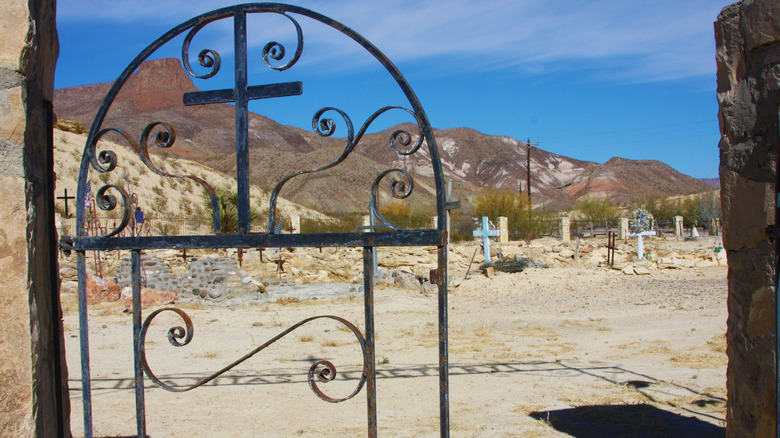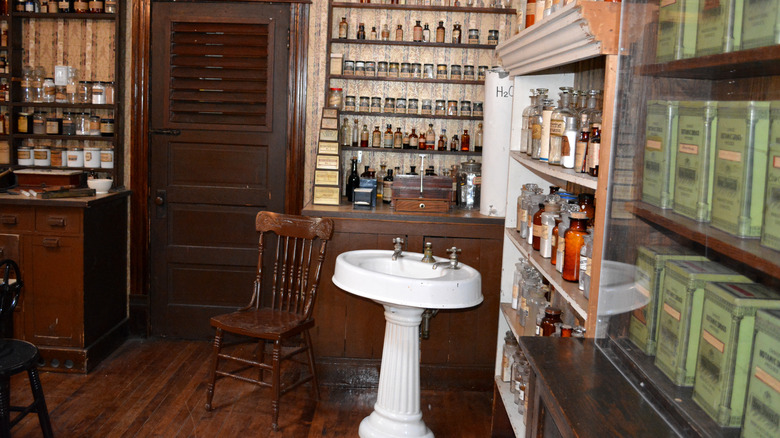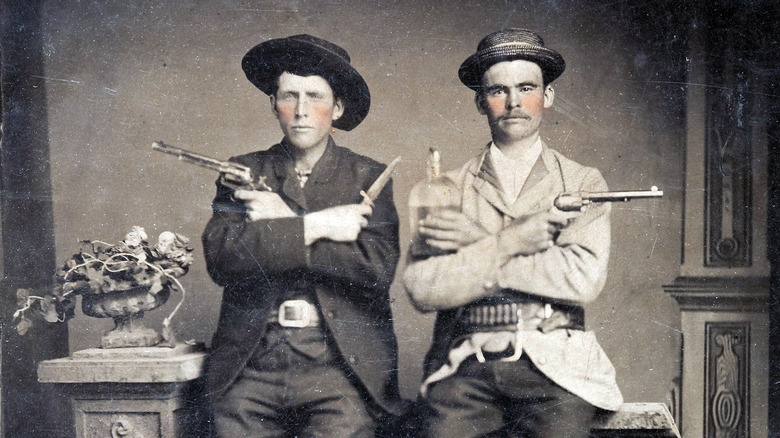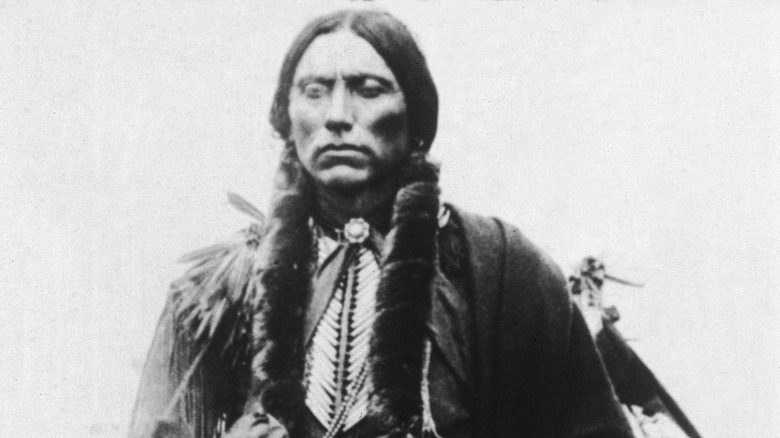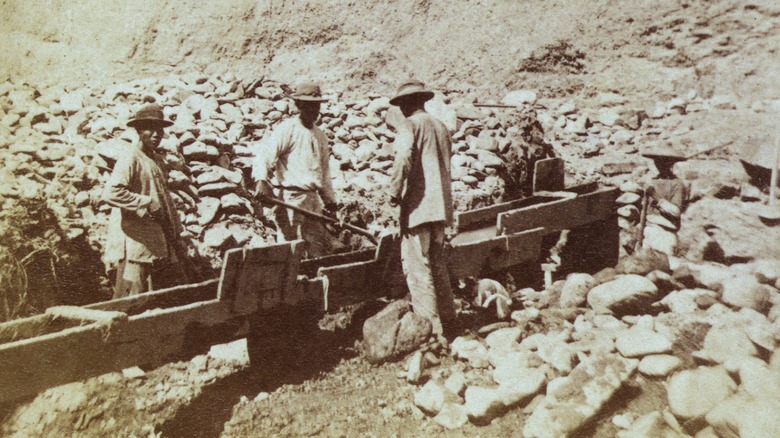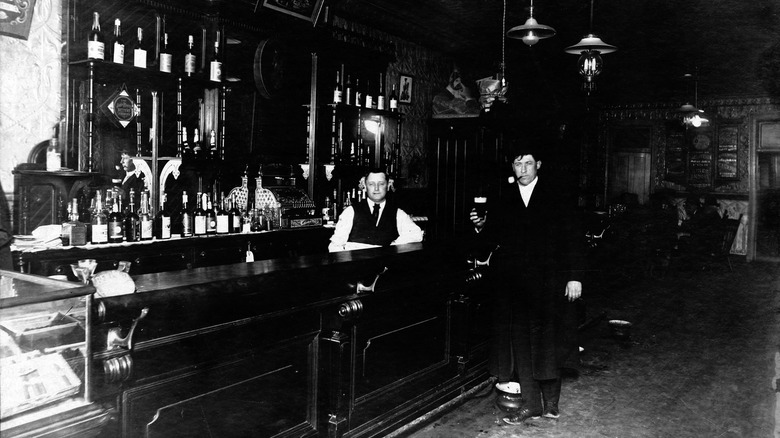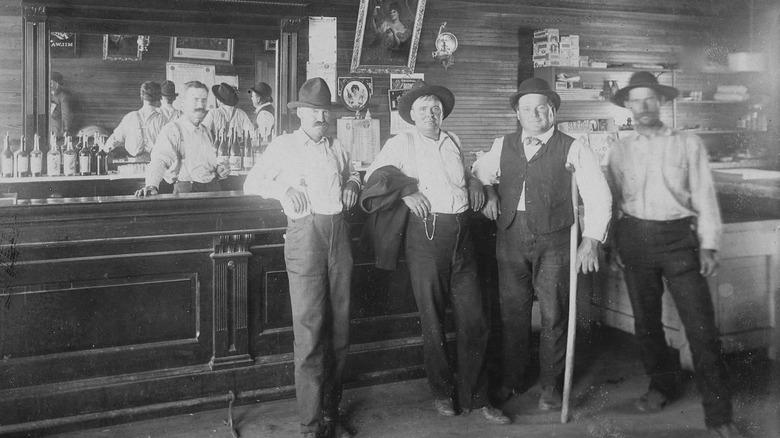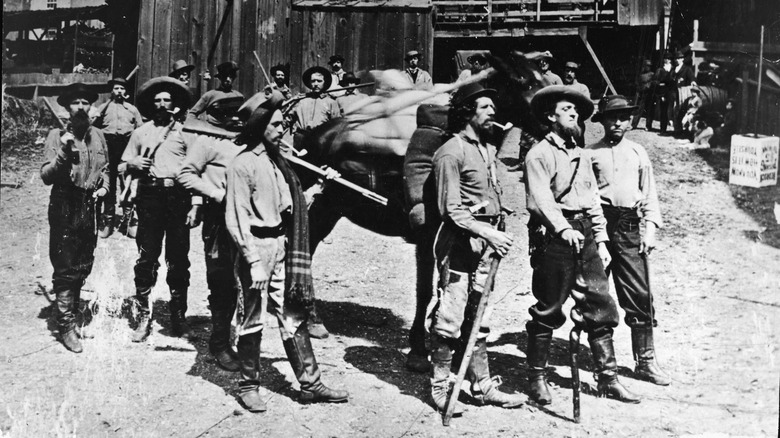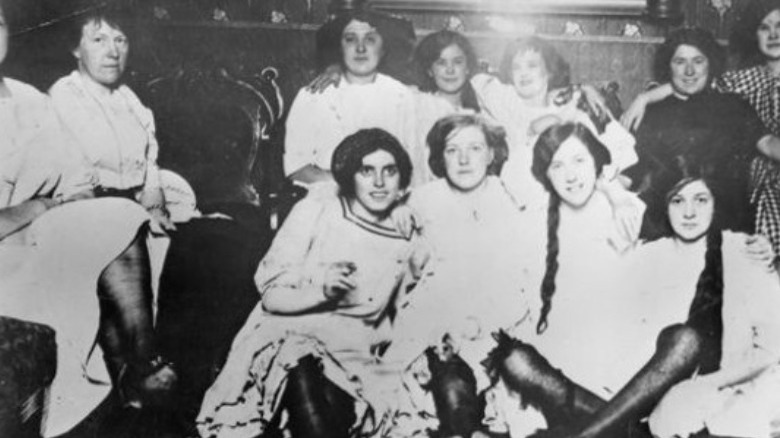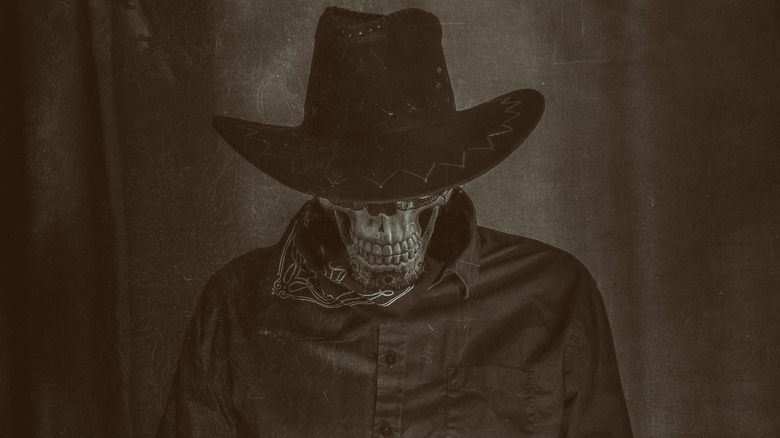Why You'd Never Survive Life In The Wild West
When the stresses of modern living get to be just too much — and that's a lot of the time, let's be honest — it's fun to think of what other time periods in history would be more fun to live in. And the Old West? Heck yes, where do we sign? The simplicity of life on the frontier, with a horse as a constant and faithful companion. Sleeping under the stars, cooking over a campfire, sidling into town to refresh supplies. Maybe setting up a general store or a saloon. Sounds pretty great, right?
Only, we know from the movies that there was a heck of a lot more bloodshed and general nastiness going on in the west ... right? Here's where things get tricky. The Smithsonian says that a lot of that came from Theodore Roosevelt, who called the bloodshed that went along with westward expansion a "'healthy sign of the virile strength' of the American people." Yikes.
Interestingly, they also suggest that attitude was both the jumping-off point for stories of the lawless West, and it's also getting a bit of a rewrite in recent history. Life in the West was much more nuanced; even life in Dodge City — famously one of the most lawless of towns — was based largely on early gun violence and a series of myths. That's not to say it wasn't dangerous: It was, it's just that all the reasons you wouldn't have survived aren't necessarily the ones the movies show you.
You might die before even making it out West
Before anyone could survive in the American West, they had to get there — and there was a pretty good chance of dying along the way. Britannica estimates that between the 1840s and 1860s alone, there were between 300,000 and 400,000 people who headed west just on the Oregon Trail.
Of those, the National Park Service says that one in 10 died before they reached the promised land. There were an almost shocking number of ways people died, with some of the most common causes being disease, accidents, weather-related tragedies, drowning while crossing the trail's multiple rivers, and — of course — gunshot wounds.
Those are just the big ones, there were other risks, too. Rattlesnake bites could turn deadly, and at the time, bison were still all over the place. A stampeding herd could quickly and easily overrun a wagon train, and they did. The animals traveling with the convoy were also a major danger: Most traveled with their own herds that included oxen, horses, and mules, and riding accidents weren't the only risk. People were kicked and killed in stampedes, and perhaps the most tragic of these deaths are those who fell off wagons and were either crushed by wheels or other wagons, or dragged along behind. Welcome to the West!
Disease was rampant
When Dr. Jim Kornberg put the spotlight on "The Fastest Killer in the Old West" for True West Magazine, it wasn't a bullet — it was cholera. A bullet, after all, can only kill a very limited number of people, but cholera is the gift that keeps on giving. In 1873 alone, a major cholera epidemic swept through the west, and at this point in history, the medical community understood exactly how it was spread. The bodily fluids expelled were called "cholera poison," and in Dr. John M. Woodworth's 1,144-page report to Congress, he came to the conclusion that disinfecting everything that could be disinfected was the way to go.
Unfortunately, disinfectant was hard to come by in the West, and people kept dying. And that's just one disease. The National Park Service says that measles, scurvy, dysentery, pneumonia, and smallpox were also common.
Smallpox, says History, came to the Americas with the Spanish, and once it was there, it — and other European diseases — killed around 90% of native peoples in North and South America. Those people were driven to horrifying extremes, like an incident recounted by historian David Dary (via The New York Times). He found a newspaper account from 1878, of an Apache medicine man who — after diagnosing two babies with smallpox — "placed [them] back-to-back and with a single bullet killed both of them."
The cures could be worse than the diseases
Historian David Dary wrote "Frontier Medicine," a book that gave a disturbing look into what being a doctor in the Old West meant — both for doctors and their patients. It's grim stuff, says The New York Times, and he found that doctors were largely making things up as they went, prescribed cures that did more damage than the illness or injury, and tragically, white doctors scoffed at a treasure trove of information that could have done some real good: the medicinal knowledge of Native American tribes.
There were essentially three options for anyone who was sick or injured, and that involved waiting for a doctor (if one could be found), treating their own problems, or just giving up the ghost. If the doctor showed up, he might perform a bloodletting (and apparently, swallowing leeches was a common problem), or administer a weird medicine like the 1815 cure for arthritis and gout. That involved killing a dog, filling the body with things like turpentine, brimstone, and nettles, then roasting it over an open fire. Breathe in the fumes, and be cured! (Or not.)
It's no wonder many turned to self-medicating for chronic conditions. One of those people was Doc Holliday: Forest Tennant, MD, says (via Practical Pain Management) that he self-medicated with opium and alcohol when he developed tuberculosis, and while he lived longer than expected, he was also regularly coughing up chunks of his lungs.
There were lots of murders
Watch literally any Hollywood Western, and it'll quickly become clear that bodies were dropping left and right, nothing was sacred, and no one was safe. But is that accurate? Not really, says Montana State University professor emeritus of economics Terry Anderson. He told LiveScience that in spite of the popular depiction of the West as a place where everyone settled disputes with bullets, oftentimes, things were much more civil.
But they weren't exactly peaceful, either. The Ohio State University's Criminal Justice Research Center did a deep dive into homicide rates in the old west and found some surprising stuff. Let's take Dodge City during the boom years. Between 1876 and 1885, residents had a 1 in 61 chance of dying a violent death. Their homicide rate was around 165 per 100,000, and while that doesn't sound like much at all, let's put it in perspective. The Centers for Disease Control and Prevention say that in 2020, the homicide rate was about 7.8 per 100,000 — and that it was a huge jump from previous years.
Ohio State puts the chances of being murder in Dodge City on the higher end, and even the low end of the scale is comparatively high to today's number. They say that Oregon had the lowest homicide rate at about 30 per 100,000, and the bottom line? Being murdered was a very real and constant fear.
Native Americans died in in truly astonishing numbers
To talk about the likelihood of dying in the Old West, it's absolutely necessary to talk about the people who did the most of it. Those were, of course, the Native Americans who had been living on the land for generations, long before the Spanish landed and said, "This looks great, we'll take it." Numbers are hard to come by, but History says that it's estimated North America was home to somewhere between 5 and 15 million people when Christopher Columbus sailed up. By the end of the 19th century, there were less than 238,000 left.
Just what happened is incredibly complicated and difficult to sum up, but there are some major causes of all those deaths. Smallpox was particularly devastating, with History suggesting it was responsible for a massive death toll. A series of wars — including the Battle of Tippecanoe, the War of 1812, and the Seminole Wars — further decreased numbers, along with outright massacres, like the Sand Creek Massacre (via History).
Then, there were forced relocations like the Trail of Tears. That killed thousands of Native Americans in the 1830s, people who were forced off their ancestral homeland and forced to walk more than a thousand miles to the land that the U.S. government decided they could live on. Bottom line? The Native Americans who survived the Old West were the exception, not the norm.
Racism and xenophobia led to the deaths of people of Chinese decent
The Library of Congress says that the Gold Rush brought with it a major influx of immigrants from China. To give an idea of numbers, 20,000 Chinese immigrated to California in 1852, and with them came some serious conflict made worse by the fact that violence was sort of government-sanctioned. Chinese miners were forced to pay $20 a month under a piece of legislation called the Foreign Miners License Law, and if that doesn't sound like much, let's add that's around $675 in today's money, all in order for them to be allowed to do their job.
National Geographic says that from the moment they entered the country, Chinese immigrants were subjected to all kinds of abuses and assaults, with incidents like the deadly events of Oct. 24, 1871. That saw one of the largest mass lynchings in U.S. history, and it targeted LA's Chinese population. It was just one relatively small part of the 19th century's hatred of Chinese immigrants, and given that the Chinese, Native Americans, and Black people were all banned from testifying in court against the white majority, it was an environment where violence went unpunished.
Formally-organized groups existed for no other purpose than spearheading assaults, arson, murders, and lynchings, and included the Ku Klux Klan and the Central Pacific Anti-C***** Association. Life in the Old West could be deadly for anyone, and for anyone who was Chinese, death was around every corner.
The ingredients in your cocktail might kill you
It's no secret that some days are only survived by being able to kick back with a cocktail at the end of them, but in the Old West, even those cocktails could have been deadly.
While most Westerns might show cowboys and outlaws alike sidling up to the bar and ordering a whiskey from the town's saloon, the Tahoe Daily Tribune found that in addition to locally brewed beers and plain old whiskey, saloons were much more likely to be serving up drinks like the possibly deadly Tarantula Juice. Drinking it was something that they say "often resulted in violence," because it contained the deadly and hallucinogenic strychnine. The drink got that chill-inducing name because those who frequently partook in it often complained of the feeling they were covered in crawling spiders.
The CDC says that only small amounts of strychnine can cause strychnine poisoning and death, so that's fun. It also wasn't the only questionable substance in alcohol, either. In many saloons, it was all about stretching liquor as far as they could and raising profits. Legends of America says that meant many saloons were cutting their liquors, and serving customers a potentially deadly mix of booze with gunpowder, turpentine, and even ammonia. Drink up!
Excessive alcohol use led to many deaths
The dangers of drinking too much are well documented, and in the Old West, it wasn't just what they were drinking, but how much — starting with the fact that according to True West Magazine, it wasn't an uncommon sight to see a teenager in a saloon drinking with the adults. In fact, Arizona's official historian, Marshall Trimble, says that before many hit 16, they were in a state that today, would be classed as severe alcoholism.
Then, it's not just about age, but quantity. Paste took a look at America's history of alcohol use, and according to historian WJ Rorabaugh, people of all ages — including toddlers, who would often finish off the last sips of their parents' drinks — were starting the day with a breakfast drink, and ending with a nightcap, starting as far back as the 1700s.
Alcohol use reached a peak in the 1800s, thanks in large part to massive corn crops and the profitability of turning that into whiskey. Basically, everyone was drinking all the time, and by 1830, intake was astronomical. Let's put it this way: If someone today were to start drinking like someone in the 1830s (and please, don't do this), they'd be drinking 3.5 bottles of whiskey each and every week. Research from the book "Alcohol and Opium in the Old West" says that drinking was seen as a perfectly acceptable pastime — so much so that abuse and addiction would ultimately lead to the Temperance Movement and Prohibition.
If you or anyone you know is struggling with addiction issues, help is available. Visit the Substance Abuse and Mental Health Services Administration website or contact SAMHSA's National Helpline at 1-800-662-HELP (4357).
Mining was unbelievably dangerous
Starting with the California Gold Rush of 1849, mining operations started popping up across the west. As they did, the Independence Hall Association in Philadelphia says that more and more precious metals were found, until miners weren't just looking for gold, they were also looking for fortunes in silver, copper, lead, and zinc — all of which were key components to the nation's rapidly-advancing industries.
Montana State University professor emeritus of history Pierce Mullen says it quickly became clear just how many ways there were to die in mining. From mine collapses and explosions to falling down ladders that stretched for hundreds of feet, exhaustion played a huge part in the danger — and so did sanitation. Miners typically lived in closely-packed communities that were breeding grounds for disease, and they were drinking water contaminated by both these not-so-sanitary living conditions but also by runoff from the mines.
True West Magazine says that it was only at the beginning of the 20th century that the medical profession started to understand why so many miners were dying of lung-related disorders like tuberculosis. The start of the disease was in silicosis, which came from breathing silica-laden dust. If that didn't result in sudden and premature death, then there was a good chance something else — like carbon monoxide poisoning, the loss of a few fingers or limbs, infection, or exposure to mercury and arsenic — would.
STDs ran rampant
There were plenty of cold nights in the Old West, and companionship? Countless men headed into the arms of the so-called painted ladies and soiled doves. In other words, the era's sex workers. Unfortunately, this whole industry was set up in such a way that it almost guaranteed a shortened life for both the women and their clients. Christopher Knowlton wrote "Cattle Kingdom: The Hidden History of the Cowboy West," and in it, he took a look at the sex work industry (via Delancy Place). Once women got into the industry, there was little to no chance of getting out. Most died young of conditions made worse by things like disease, addiction, and poverty, and as historian Michael Rutter put it: "This line of work never had a good retirement plan."
According to "Medicine in the Old West," some estimates suggest that about 50% of the west's sex workers had some form of venereal disease — which was spread to clients. They did take precautions, but it's easy to see how repeatedly using solutions containing chemicals like mercury, carbolic acid, mercuric cyanide, and boric acid might be more than a little dangerous.
It's unclear how many people venereal disease killed because the cause of death was often listed on death certificates as something other than the venereal disease: Often it was called "cancer of the brain," because of the decay that late-stage syphilis caused.
One cemetery showed what a variety of deaths occurred
In 1998, archeologists excavated the cemetery of the Old West town of Seven Rivers. Sitting just outside what's now Carlsbad, New Mexico, they were hoping that the remains of those who were buried there might shed some light on just how rough life — and death — were.
They certainly did. The Los Angeles Times reported that 52 bodies were excavated, including 15 men between 18 and 45 years old. Ten suffered violent fates — and some weren't the typical sorts of Wild West-style movie deaths. William Johnson, for example, was killed by a shotgun blast to the face. His killer and crime? His father-in-law, who was upset to learn he'd fought in the Civil War ... for the North. Another man was killed by a chest full of buckshot after he'd been living for about a year with the blade of a knife broken off in his shoulder. There was a saloon worker who was shot and killed, another skull with a bullet hole in it, and another who had their real problems start when their leg was amputated.
And what about the other bodies? There was a whole family who died of dysentery right after getting into town, and a whole bunch of children under 2 years old. Most of those 14 children had died of diseases that modern medicine has mostly cured — like measles and scarlet fever — implying that death didn't care who you were or how old, young, or idealistic you were ... it was coming.
